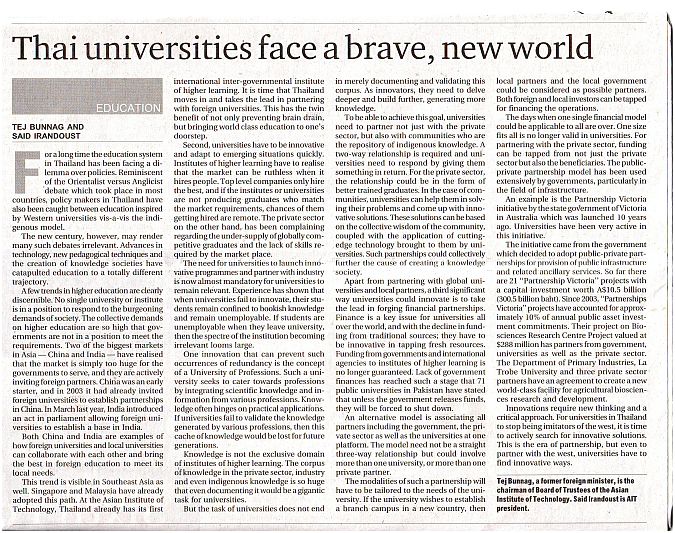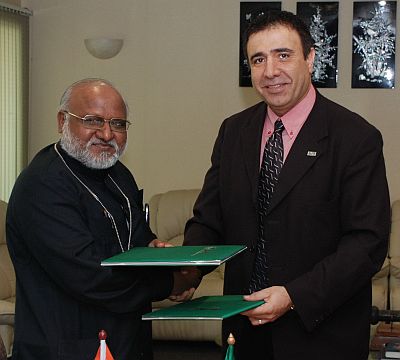For a long time the education system in Thailand has been facing a
dilemma over policies. Reminiscent of the Orientalist versus Anglicist
debate which took place in most countries, policy makers in Thailand
have also been caught between education inspired by Western
universities vis-a-vis the indigenous model.
The new century, however, may render many such debates irrelevant.
Advances in technology, new pedagogical techniques and the creation of
knowledge societies have catapulted education to a totally different
trajectory.
A few trends in higher education are clearly discernible. No single
university or institute is in a position to respond to the burgeoning
demands of society. The collective demands on higher education are so
high that governments are not in a position to meet the requirements.
Two of the biggest markets in Asia - China and India - have realised
that the market is simply too huge for the governments to serve, and
they are actively inviting foreign partners. China was an early
starter, and in 2003 it had already invited foreign universities to
establish partnerships in China. In March last year, India introduced
an act in parliament allowing foreign universities to establish a base
in India.
Both China and India are examples of how foreign universities and
local universities can collaborate with each other and bring the best
in foreign education to meet its local needs.
This trend is visible in Southeast Asia as well. Singapore and
Malaysia have already adopted this path. At the Asian Institute of
Technology, Thailand already has its first international
inter-governmental institute of higher learning. It is time that
Thailand moves in and takes the lead in partnering with foreign
universities. This has the twin benefit of not only preventing brain
drain, but bringing world class education to one's doorstep.
Second, universities have to be innovative and adapt to emerging
situations quickly. Institutes of higher learning have to realise that
the market can be ruthless when it hires people. Top level companies
only hire the best, and if the institutes or universities are not
producing graduates who match the market requirements, chances of them
getting hired are remote. The private sector on the other hand, has
been complaining regarding the under-supply of globally competitive
graduates and the lack of skills required by the market place.
The need for universities to launch innovative programmes and partner
with industry is now almost mandatory for universities to remain
relevant. Experience has shown that when universities fail to innovate,
their students remain confined to bookish knowledge and remain
unemployable. If students are unemployable when they leave university,
then the spectre of the institution becoming irrelevant looms
large.
One innovation that can prevent such occurrences of redundancy is the
concept of a University of Professions. Such a university seeks to
cater towards professions by integrating scientific knowledge and
information from various professions. Knowledge often hinges on
practical applications. If universities fail to validate the knowledge
generated by various professions, then this cache of knowledge would be
lost for future generations.
Knowledge is not the exclusive domain of institutes of higher
learning. The corpus of knowledge in the private sector, industry and
even indigenous knowledge is so huge that even documenting it would be
a gigantic task for universities.
But the task of universities does not end in merely documenting and
validating this corpus. As innovators, they need to delve deeper and
build further, generating more knowledge.
To be able to achieve this goal, universities need to partner not just
with the private sector, but also with communities who are the
repository of indigenous knowledge. A two-way relationship is required
and universities need to respond by giving them something in return.
For the private sector, the relationship could be in the form of better
trained graduates. In the case of communities, universities can help
them in solving their problems and come up with innovative solutions.
These solutions can be based on the collective wisdom of the community,
coupled with the application of cutting-edge technology brought to them
by universities. Such partnerships could collectively further the cause
of creating a knowledge society.
Apart from partnering with global universities and local partners, a
third significant way universities could innovate is to take the lead
in forging financial partnerships. Finance is a key issue for
universities all over the world, and with the decline in funding from
traditional sources; they have to be innovative in tapping fresh
resources. Funding from governments and international agencies to
institutes of higher learning is no longer guaranteed. Lack of
government finances has reached such a stage that 71 public
universities in Pakistan have stated that unless the government
releases funds, they will be forced to shut down.
An alternative model is associating all partners including the
government, the private sector as well as the universities at one
platform. The model need not be a straight three-way relationship but
could involve more than one university, or more than one private
partner.
The modalities of such a partnership will have to be tailored to the
needs of the university. If the university wishes to establish a branch
campus in a new country, then local partners and the local government
could be considered as possible partners. Both foreign and local
investors can be tapped for financing the operations.
The days when one single financial model could be applicable to all
are over. One size fits all is no longer valid in universities. For
partnering with the private sector, funding can be tapped from not just
the private sector but also the beneficiaries. The public-private
partnership model has been used extensively by governments,
particularly in the field of infrastructure.
An example is the Partnership Victoria initiative by the state
government of Victoria in Australia which was launched 10 years ago.
Universities have been very active in this initiative.
The initiative came from the government which decided to adopt
public-private partnerships for provision of public infrastructure and
related ancillary services. So far there are 21 "Partnership Victoria"
projects with a capital investment worth A$10.5 billion (300.5 billion
baht). Since 2003, "Partnerships Victoria" projects have accounted for
approximately 10% of annual public asset investment commitments. Their
project on Biosciences Research Centre Project valued at $288 million
has partners from government, universities as well as the private
sector. The Department of Primary Industries, La Trobe University and
three private sector partners have an agreement to create a new
world-class facility for agricultural biosciences research and
development.
Innovations require new thinking and a critical approach. For
universities in Thailand to stop being imitators of the west, it is
time to actively search for innovative solutions. This is the era of
partnership, but even to partner with the west, universities have to
find innovative ways.
The original article can be read at this
link.


